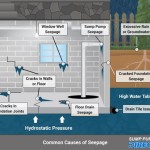Why Does My Basement Flood When I Do Laundry?
A flooded basement after doing laundry is a common and frustrating problem. It can be a significant source of stress and damage, especially if the flooding is frequent or severe. Understanding why your basement floods during laundry can help you identify the root cause, prevent future occurrences, and potentially save you from expensive repairs. This article will explore the most common reasons for basement flooding during laundry, providing an overview of the issues and potential solutions.
Clogged Drain Lines
One of the most common culprits for basement flooding during laundry is a clogged drain line. The laundry drain typically connects to the main drain line, which often runs through the basement. If this drain line becomes blocked with debris, hair, or other obstructions, water can back up into the basement when the washing machine discharges its water. This can lead to a slow and steady buildup of water, eventually overflowing into the basement.
To prevent clogged drains, it is crucial to regularly inspect and clean them. This can be done by pouring a solution of baking soda and vinegar down the drain, followed by hot water. Avoid using harsh chemicals that can damage the pipes. If the drain is severely clogged, it may be necessary to call a professional plumber to clear the blockage.
Broken or Leaky Washing Machine Hoses
Another common cause of basement flooding during laundry is a broken or leaky washing machine hose. These hoses connect the washing machine to the drain line and water supply. Over time, these hoses can crack, wear down, or become loose, leading to leaks. These leaks can go unnoticed initially but can quickly escalate into a major flooding issue if not addressed promptly.
To prevent leaks from washing machine hoses, regularly inspect them for signs of damage, such as cracks, bulges, or rust. Consider replacing them every few years, regardless of their condition, as rubber hoses deteriorate over time. When choosing new hoses, opt for stainless steel braided hoses, which are more durable and less prone to leaks.
Inadequate Sump Pump Capacity
A sump pump is a vital component for managing groundwater and preventing basement flooding. It collects water that seeps into the basement due to heavy rain, snowmelt, or ground saturation, and pumps it away from the foundation. When a sump pump is undersized or malfunctioning, it may struggle to keep up with the water flow, leading to flooding during laundry cycles, especially if the washing machine adds additional water to the system.
To ensure proper sump pump capacity, consider having it inspected and serviced regularly by a qualified professional. Ensure the sump pit is clear of debris and that the pump's float switch operates correctly. If your basement is prone to flooding or you frequently use a high-capacity washing machine, it may be necessary to upgrade to a more powerful sump pump.
Water Pressure Issues
High water pressure can also contribute to basement flooding during laundry. Excessive pressure can strain the washing machine's hoses and connections, increasing the risk of leaks. Additionally, high water pressure forces more water into the drain system, putting more stress on the entire drainage system and potentially leading to backups.
To address water pressure issues, consider installing a pressure-reducing valve (PRV) at the main water supply line entering your home. This valve can regulate the pressure to a safe level, reducing the strain on your plumbing system and reducing the risk of leaks.
Improper Grading and Drainage Around the House
The way your house is graded and the drainage system surrounding it can also play a role in basement flooding. If the ground around your home slopes towards the foundation, it can direct rainwater and runoff towards your basement. Likewise, inadequate drainage around the foundation can lead to water pooling and seeping into the basement.
To prevent basement flooding caused by poor grading and drainage, ensure the ground slopes away from the foundation to direct water away from the structure. Install gutters and downspouts to divert rainwater away from the foundation. Ensure the downspouts discharge water at least 5-10 feet away from the house.

What To Do When Your Washing Machine Floods Flood Services

Tips To Prevent Flooding In Upstairs Laundry Acuity

Reasons Your Basement Could Flood This Winter

Get Help For Basement Flooding From A Washing Machine Leak

Why Does My Basement Flood When It Rains Jersey Shore Crawlspace

What To Do If Your Washing Machine Floods
.$blog_image_desktop$.png?strip=all)
Basement Flooding

Flooded Basement Common Causes And Prevention Tips Preferred Mutual

6 Things To Do When Your Basement Floods Stephens Plumbing

Basement Flood Protection Prevention Mitigation Tips Peak Sewer Edmonton
See Also








